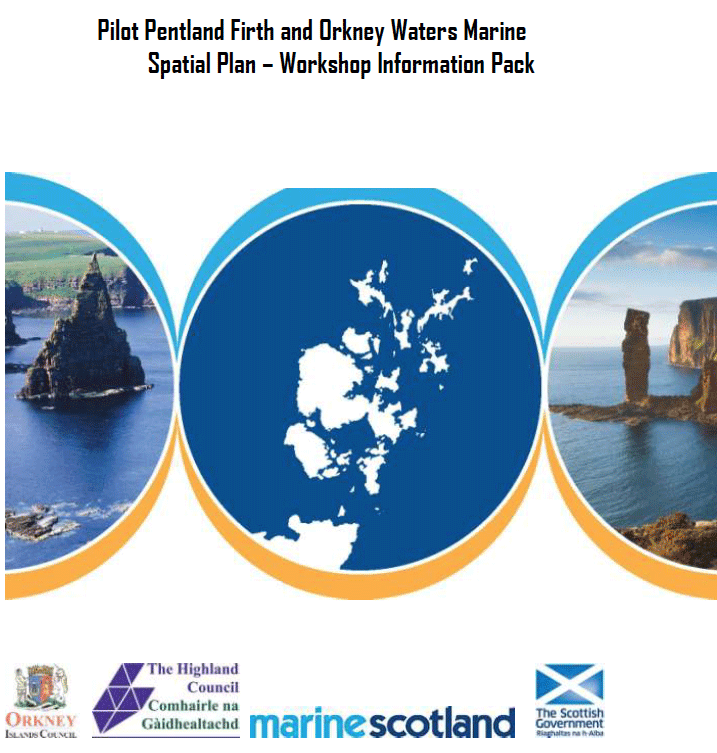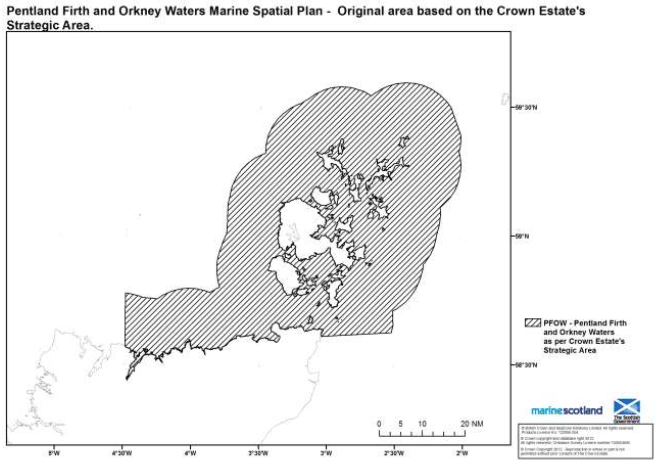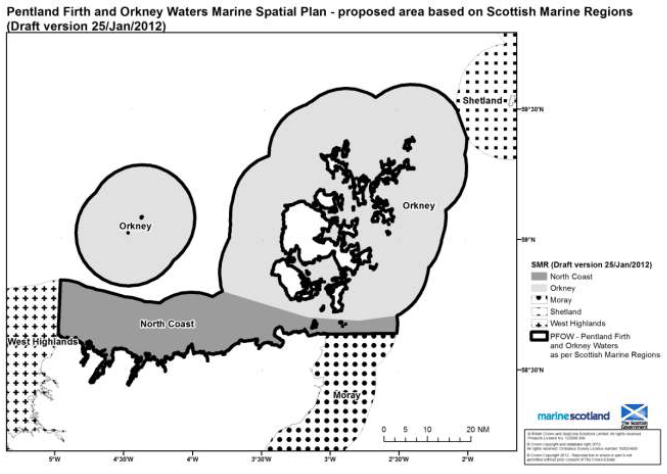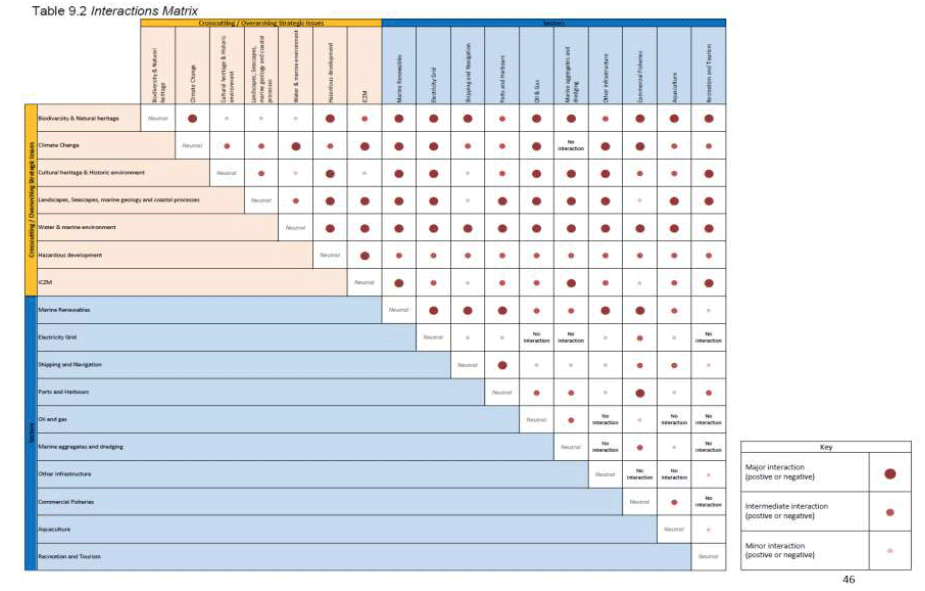Pilot Pentland Firth and Orkney Waters Marine Spatial Plan: Consultation Analysis
This document analyses the results of a variety of consultation opportunities in relation to the development of the pilot Pentland Firth and Orkney Waters marine spatial plan. This analysis will inform the next stage of the development of the marine spati
10. Annex 3 Information Pack Provided to Participants at the Workshops

Workshop Agenda
Pentland Firth Orkney Waters or PFOW 1 st & 4 th of JULY WORKSHOP
Main Aims:
- To provide stakeholders with an opportunity to contribute to the development of the pilot Pentland Firth and Orkney Waters Marine Spatial Plan
- To provide an opportunity to discuss the potential advantages and disadvantages of marine development for coastal communities
Venues:
Kirkwall King Street Halls
Thurso Pentland Hotel
| 10.00 | Registration and coffee |
|---|---|
| 10.15 | Marine Scotland introduction (Tracy McCollin, Marine Scotland) |
| 10. 25 | ICIT MESMA (Monitoring and Evaluation of Spatially Managed Areas) introduction (Kate Johnson, ICIT) |
| Marine Scotland, Orkney Islands Council And Highland Council | |
| 10.35 | Session One Based on Sections 4 - 10 of the Planning Issues and Options Report |
| 11.15 | Short break |
| 11.30 | Session Two Based on Section 11 -12 of the Planning Issues and Options Report |
| 12.45 | Lunch |
| Icit Heriot-Watt University | |
| 13.30 | "The Future of our Seas" feedback from the European marine planning project and a PFOW community roles/benefits workshop led by ICIT/Heriot-Watt University. |
| 14.30 | Short break |
| 14.40 | Workshop continued… |
| 15.30 | A summary of University marine science research in the Pentland Firth and Orkney Waters by Professors Side and Gibb. |
| 15.50-16.00 | Wrap up and close |
Format of Workshops
- Participants are divided into small groups, each table will have a facilitator to record the discussion
- The morning workshop is divided into two sessions, each dealing with a different part of the Planning Issues and Options Paper
- This does not preclude discussion of the Environmental Report where participants wish to contribute comments
- At the afternoon workshop there will be feedback on the results of the European project and a comparison of experience across several countries
- The afternoon workshop aims to generate discussion about three social and economic themes which are important to the Pentland Firth and Orkney Waters plan and to European policy and legislation:
Theme 1 concerns the reach and efficacy of the consultation process.
Theme 2 explores the common ownership of space and the rights to resources in the marine environment.
Theme 3 considers community shares in revenues from marine developments and the control of local issues.
- A series of questions have been suggested for each session (see this document)
- The questions are intended to encourage discussion but are not fixed and participants are encouraged to raise any points they have in the relevant session
- There are a wide variety of stakeholders attending the workshop and the facilitators will ensure that everyone gets to have their say, this may mean moving the discussion on when necessary
- Very specific and/or technical issues can be raised but participants are encouraged to send in any very detailed comments via the Respondent Information Form and/or arrange a one to one meeting with the Working Group
Morning Workshop
Session One
Based on Sections 4 - 10 of the Planning Issues and Options Report. These sections of the report deal with the background to the plan preparation process and the legal and policy context against which it is being prepared. There is information regarding the knowledge underpinning the plan, the purpose, users, status and spatial extent of the plan and a description of the guiding principles, strategic vision, aims and objectives. Section 9 also identifies the strategic issues and interactions and Section 10 discusses the spatial strategy and information required.
The Working Group has provided some questions below to encourage discussion of these issues and provided the relevant text from the Planning Issue and Options Paper that is associated with each of the questions.
The questions are not fixed and if participants have comments on other parts of these sections of the Planning Issues and Options Paper or the Environmental Report they are encouraged to raise them.
Q1. Purposes of the Marine Spatial Plan
Section 6 Page 22:
The main purposes of the pilot plan are:
- To establish a coherent strategic vision and objectives to achieve sustainable development;
- To set out policies to support the delivery of sustainable development;
- To produce and use relevant, reliable and robust information to support the plan policies, inform decision making and support the sustainable management of the marine environment; and
- To develop a framework for integrating marine planning with terrestrial planning.
Has anything been missed?
Should additional purposes be added?
Facilitator's Notes (Purposes of the Marine Spatial Plan)

Q2. Users of the Marine Spatial Plan
Section 6 Page 23:
The pilot Pentland Firth and Orkney Waters Marine Spatial Plan Working Group has identified the following primary users of the pilot plan:
- Marine Scotland Licensing and Operations Team will use the plan to inform marine licensing, consents under Section 36 of the Electricity Act and other appropriate licensing decisions;
- Orkney Islands Council (Orkney Harbour Authority) will use the plan to inform decisions on Works Licence applications;
- Statutory agencies such as Scottish Natural Heritage and the Scottish Environment Protection Agency could use the plan to inform the consultation responses they make to relevant licences and applications;
- Highland Council and Orkney Islands Council could potentially use the plan to inform decisions on relevant planning applications i.e. developments in the coastal zone;
- Businesses and individuals that wish to deliver new development in the marine area e.g. renewable energy companies, port infrastructure developers and aquaculture businesses;
- A variety of existing marine users including those involved in fishing, diving, recreational activities, transportation, shipping and navigation; and
- Local communities
Do you agree these are the main users?
Any additional users?
Facilitator's Notes (Users of the Marine Spatial Plan)

Q3. Spatial Extent of the Plan
Section 6 Page 24
The Planning Issues and Options Paper suggests two areas for the plan:
1. An area based on the Crown Estate's Strategic Area
2. An area based on the proposed North Coast and Orkney Proposed Scottish Marine Regions
Which area do you think should be used for the plan?


Facilitator's Notes (Spatial Extent of the Plan)

Q4. Strategic Issues and Interactions
Section 9 Page 33
The assessment of strategic issues and interactions will be an important starting point for the development of appropriate policies to reconcile potential planning issues. The aspiration will be to reduce the potential for future conflict or adverse effects as a result of growth or change for key sectors. The pilot marine spatial plan will also identify where there are compatible interactions and potential synergies between marine sectors, socio-economic and environmental receptors.
The identification of strategic issues and potential interactions between sectors in this consultation paper builds on work that was carried out in the Pentland Firth and Orkney Waters Marine Spatial Plan Framework. The framework process included consultation workshops with stakeholders to identify the likely interactions between marine sectors and activities and the likely extent of that interaction e.g. small, medium and large. This information has been reviewed and updated by the Working Group in consultation with stakeholders and presented in Table 9.1 and Table 9.2 for consultation.
Table 9.2 is shown below.
Sectors or cross cutting issues to be added?
Changes to interactions?
Facilitator's Notes (Strategic Issues and Interactions, see matrix on previous page)

Morning Workshop
Session Two
Based on Section 11 -12 of the Planning Issues and Options Report. These two sections deal with the crosscutting or overarching policies and sectoral policies. Both sections describe the policies that are considered important in achieving a sustainable approach to economic growth. In both sections a preferred policy option is proposed for each topic or sector and, in some cases an alternative option. Input is required from stakeholders to ensure that the proposed policies are fit for purpose.
The Working Group has provided some questions below to encourage discussion of these issues and provided the relevant text from the plan that is associated with each of the questions.
The questions are not fixed and if participants have comments on other parts of these sections of the Planning Issues and Options Report or the Environmental Report they are encouraged to raise them.
These sections are very detailed and contain a lot of information about the various options. Participants are encouraged to read the policies relevant to their area of interest before the workshop in order to prepare their input.
Q5. Crosscutting or Overarching Marine Planning Policies
Section 11 Page 49
Crosscutting or overarching policies seek to safeguard important environmental, cultural and infrastructure resources e.g. natural habitats, historic assets and existing pipelines. These policies are of potential relevance to many types of development and are not specific to any one sector. They aim to ensure that the environmental objectives identified through the Strategic Environmental Assessment and the wider marine planning process are effectively integrated into the pilot marine spatial plan. The guiding principles and themes set out in Section 7 of this consultation paper have also informed the identification of the crosscutting / overarching policy areas below. Each policy area listed below has a suggested preferred approach along with supporting spatial information and, where applicable, an alternative approach.
The policies:
1a: Sustainable Development
2a: Integrating marine and coastal development
3a: Nature conservation designations
3b: Protected species
3c: Wider biodiversity and geodiversity interests
3d: Non-native species
3e: Landscape and seascape
4a: Cultural and Historic Environment
5a: Water environment
6a: Coastal erosion and flooding
7a: Waste management and marine litter
8a: Safeguarding existing pipelines, electricity and telecommunications cables
9a: Hazardous development and Health and Safety Executive consultation zones
10a: Defence
Should more policies be added?
Changes to proposed and alternative policies?
Facilitator's Notes (Crosscutting or Overarching Marine Planning Policies)

Q6. Sectoral Policies
Section 12 Page 71
Sectoral policies have been identified to address the marine planning issues of relevance to identified business and/or infrastructure related sectors. These policies will set out the relevant planning considerations that will be considered when assessing consent applications for development proposals and/or activities undertaken by these various sectors e.g. marine renewable energy projects and harbour developments. The sectoral policies will also set out how the potential effects of future development, or related activities, will be assessed in relation to existing sectoral activities e.g. commercial fisheries and tourism and recreation.
The policies:
11: Marine renewable energy
12: Electricity infrastructure to support marine renewable energy projects
13: Shipping, Navigation and Marine Safety
14: Ports and harbours
15: Oil and Gas
16: Marine aggregates and dredging
17: Development of coastal protection and flood defence infrastructure
18: Development of new telecommunication cables
19: Commercial fisheries
20: Aquaculture
21: Tourism and recreation
Should more policies be added?
Changes to proposed and alternative policies?
Do you think the marine spatial plan should "zone" areas of sea for specific developments? What are the key challenges and issues that could arise from taking this approach? What are the potential advantages and disadvantages? (see page 73)
Facilitator's Notes (Sectoral Policies)

Afternoon Workshop
The European Commission have sponsored a large research project into marine planning in Europe in support of a policy ambition to create jobs and economic growth from marine resources. Energy and food security are the priorities. The four year €8million project is approaching completion and has examined nine case studies across thirteen countries with the aim to guide policy and practice ( www.mesma.org). ICIT Heriot-Watt University are leading a case study of the Pentland Firth and Orkney Waters which is the foremost example of marine energy development planning in the world. Large arrays of wave and tidal energy devices in near shore waters create particular challenges for planning at sea and on land. Operations cross the land sea divide with both costs and benefits for local communities.
At the afternoon workshop there will be feedback on the results of the European project and a comparison of experience across several countries. The workshop aims to generate discussion about three social and economic themes which are important to the Pentland Firth and Orkney Waters plan and to European policy and legislation. Theme 1 concerns the reach and efficacy of the consultation process. Theme 2 explores the common ownership of space and the rights to resources in the marine environment. Theme 3 considers community shares in revenues from marine developments and the control of local issues. A full list of the questions to be addressed is attach below. Again, they are not fixed but are designed to generate debate. The format for the workshop will be similar to Part 1. If you have time you might like to read the paper at: http://www.sciencedirect.com/science/article/pii/S0308597X12001716
The Future of Our Seas Workshops - Kirkwall and Thurso July 2013
Themes and Questions for Part 2 - ICIT Heriot-Watt University
Theme 1 - Can consultation work?
i. Consultations tend to attract responses from professionals and activists. How can all affected people in the community of stakeholders and the public become more engaged?
ii. Respondents at previous workshops have talked of 'consultation fatigue' complaining of too many and similar consultations without visible effect. How can the burden of responding be reduced and the efficacy increased?
Theme 2 - Ownership and rights?
i. To what extent is common ownership of the seas an important issue a) for you personally, b) for the local community, and c) for society as a whole?
ii. Ownership and rights to space and resources are different for the seabed, the sea surface and the water column in between (see graphic). What problems do you think this will cause and do you have experience of such conflicts?
Theme 3. Community Benefits?
In 1974 local MP Jo Grimond successfully argued in parliament for special council powers in Shetland, and subsequently in Orkney, to control North Sea oil developments in the islands.
"The Bill, which deals with the situation that has arisen owing to the discovery of oil off Shetland, may well point the way to better methods of controlling developments consequent upon oil discoveries in other parts of Britain. But the Bill has arisen because of the Shetland situation, and the Shetland situation is to some extent a special one . I believe it is essential that the impact of oil on a rather unique island community such as Shetland - an impact which may be extremely serious but which certainly will not go on for ever and may be over after 50 years -should be controlled carefully . We must not sacrifice the long-term future of the community.
Control should be exercised with several aims in view. The first is the well-being of all Shetlanders and all their descendants. The second is the maintenance of their traditions, which are largely Norse in origin and which differ from the traditions of much of the rest of Britain. The third is the preservation of the best land of Shetland - here I have in mind both its agricultural value and its beauty - and the protection of Shetland's existing fisheries, agriculture and industry.
We should also arrange for the retention in the islands of a fair share of the income which will arise from these discoveries. We should ensure that this income can be used for the general well-being and for such purposes as making good if pollution should take place and the ultimate rehabilitation of sites which may be used and then discarded. The fifth aim is that service and other industries connected with the oil should be introduced in an orderly manner and at a speed and on a scale which the islands can absorb without disruption."
i. Should the affected coastal communities share directly in the revenues created by marine development in the adjacent waters and how might this be done?
ii. To what extent do you think the 'special situations' in coastal communities (such as those described by Jo Grimond) exist today and how should control be exercised?
Contact
There is a problem
Thanks for your feedback
